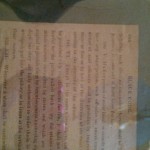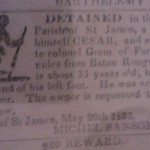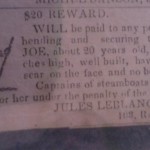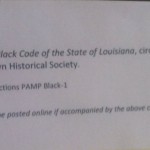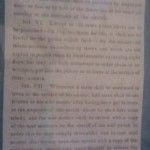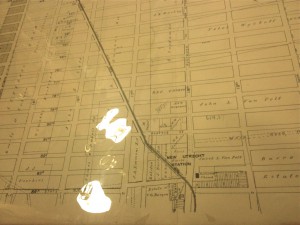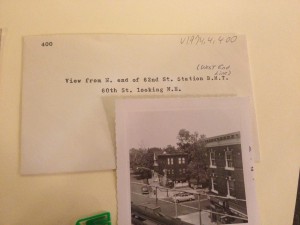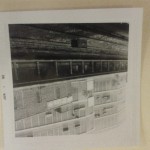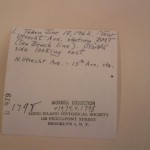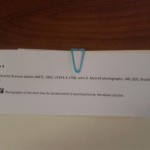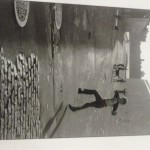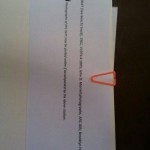During our class visits to the Brooklyn Historical Society I found myself getting more and more enthralled with the amazing atmosphere that the building. When I walked into the building I felt like I had walked through a wormhole and was back in time in the library of a large manor home, expecting a lord of some sort to come in and ask me to leave. On our first day we met Robin Katz who stood out from everyone else in the way she spoke and her apparent display of knowledge. During our three visits we looked at articles pictures and advertisements that ranged in age from over five decades to almost two hundred years old. These primary sources were well preserved and displayed a great deal of information. It was like looking through a window through the fabric of time and seeing things from the point of view of people who lived before my time. One of the first things I saw at the BHS was a map of subway stations in Brooklyn that was over fifty years old. I was surprised to know that a lot of stations are still there today and some are even still in use. During our second and third visits we looked at different articles and advertisements pertaining to slaves. These were tough subjects to view and a lot of the things we looked at made me really angry. However I am glad that I got the chance to see these materials. In doing so I was able to learn and grow as a person and feel really good about the time we live in. I wouldn’t trade my experience there for anything. I also hope that I get the chance to go back and do some self-study research so that I can appreciate the entirety of what the BHS has to offer.
Tag Archives: BHS
My Experience at the BHS
Visiting the Brooklyn Historical Society was a complete new experience for me because ive never went to a place where real primary sources were archived throughout the years and be able to use in research. its like a time machine and being able to peer into the past and see some of the past and how it was. it has also changed how i can do research and use primary sources to back up my thesis, or support an argument, or enhance a research paper. it has also changed how i view and read the book beloved and any other piece of literature that is in that time period and about slavery such as the “runaway slave profile” by Franklin/Schwninger it gave some examples and descriptions on how the slave owners put slave ads on newspapers and how they described them,whether they were dark skin, mulatto, etc and any other unique features that could identify the person in the ad. Even though they gave descriptions and how they did it and what the ads looked like it does not compare to actually physically seeing and and reading it for yourself what the ads looked like and what they contained. for example the caricature of a slave next to the ad to signify that it was a slave ad. many different things ive learned and experienced. it has changed how i look at primary sources and where to find them. i hope to return to the BHS in the future and take advantage of the primary sources
Visiting BHS
After visiting BHS, over the semester it has been a informal experience. Learning about how Brooklyn used to be and what it is now is amazing. I see all the neighborhoods and how much has stayed the same and also how much has changed. I got to see that Coney Island was still a place where people could enjoy themselves. Viewing the ads for the run away slaves,I had to pay close attention to the details that the slave-owners would write specific things about their slaves but the value for wanting them back was very low. It told me that there was a chance for that if the slave was returned that they would be killed or tortured.
Reading the letter for the slave asking his owner to buy his freedom was very different. One, because slaves weren’t educated and two most couldn’t buy their freedom because they didn’t have much money and three their owners wouldn’t allow it because they still wanted to keep them. Overall, after all my three visits to BHS i have gained alot of information that i would have never knew about without attending the class sessions held their. Presenting to the class was a good experience, it made me feel more comfortable to present in front of classmate because i knew what i would say. Group 6; was the group i was in and i believed that we worked great together and accomplished our goal.
New Learning Experience at BHS
Visiting Brooklyn Historical Society (BHS) was completely a new learning experience for us. We visited BHS three times and each time there were something new and interesting to learn. In our first visit we got opportunity to know little more about Brooklyn’s history through the maps and photographs dated century back. We made this visit when we were reading “Only The Dead Know Brooklyn” by Thomas Wolfe. Then our recent two visits to BHS were focused on the slavery time period. These visits were based on our readings; “Beloved” by Toni Morrison and “Runaway Slaves” by John Franklin and Loren Schweninger. In these visits we looked at the journals and newspaper ads of owners whose slaves ran away from them. These two visits were different than the first visit because we worked in groups to learn the materials. We also did a presentation for other group members and BHS staff members based on our ideas and observations. All those primary resources, group works, and most importantly the co-operative staff members of BHS enhanced our overall experience at BHS.
My Experience at BHS
I enjoyed our visits to the Brooklyn Historical Society. Ive never been there before so i did not know what to expect. Although we only got to look at a few pieces, i learned a lot from our visits. During our first visit we were reading “Only The Dead Know Brooklyn”, and so we got a chance to look at the history of Brooklyn. We saw maps of the borough of Brooklyn that showed streets, where the train and railroads crossed, and also noted many differences of Brooklyn today. From the map, we noticed that places that are now a part of Queens, were once in Brooklyn. This experience was cool because i didn’t think i could get my hands on primary sources like these. During our second visit, we looked at slave advertisements during the time we were reading “Beloved”. While reading the advertisements I understood the terms used to describe them because it was defined in the book. The slave ad that we saw at our table was in a newspaper from 1825, and the newspaper was still in good condition which was interesting to know it was well preserved and that i had the pleasure of reading it. In the last visit to BHS, we had a second chance to look at the same slave ads and we had to present. It was a nice experience since we didnt see everyone’s ads, but we got to hear what they saw. Overall, it was a intriguing experience.
Visting BHS – Group 2
The first ad, is from the Long Island Star newspaper, published on January 10th, 1822. The newspaper is from Brooklyn, NY, about an indentured boy between the ages of 11-12 named David Smith. Our first highlight was the description, “Indented colored boy.” We were confused on why they said indented, and later were informed that it might have been a slang term for “indentured.” The ad also made us wonder a lot on why it was posted in the first place. The Master doesn’t want the boy, and as a group, we came to an agreement that the only reason that he posted up the ad in the first place is the fact that the boy was not a slave, and was an indenture, a servant with a contract that will expire after a certain amount of years and will later be free, he might be responsible for any negative actions that David Smith did while he ran away. He was described as a “great rogue,” and that the master tried to give the papers to the boy’s father but he refused to accept them. That also raised the question, since the boy’s father is colored as well, is he free or not? and will that affect the outcome on the privilage of accepting those papers.
The second article we got was an ad from Louisiana Slave Pamphlet, from 1835. It was about a runaway, Henry, which was about 18 years old, and was described as “middle sized, swelled cheeks, silky locks, black skin, well built, and speaks English and French.” Last seen on April 27th, carrying a basket of vegetables at the market. And it was supposed that he had fled on a steam boat. There was a $100 reward on whomever found and returned him. We noticed this ad was a bit different from the first one because this one had an icon, had a reward and the boy was described in a lot more detail than the David was.
In the ad, the boy resembles the lost song (either Buglar or Howards) of Sethe in the novel “Beloved.” Because in the ad, it says a rogue boy weas lurking in Brooklyn and owner couldn’t handle him.
In “Runaway Slaves,” Louisvilla Journal has published about a runaway slaves profile detail that says, he might go to Nashville where his mother lives as a free person.
Comparing to the novel “Beloved” and “Runaway Slaves,” the mother mentioned in Runaway slaves resembles Baby Suggs and her son Halle. Because in the novel “Beloved” Halle was out of the seen most of the time and he really takes care of his mother. He may be sold and reached Alabama but scaped. In “Runaway Slaves” the newspaper ad mentioned that a man named Jim or Armstead ran away with a horse, probably he will run to his mother where his many acquintance lived.
Group Project Runaway Slave BHS (Brian, Danny, Simone and Nicole)
In the first slave advertisement it is a reward of $20 to find the slave named Joe. They give a brief description of his outer appearance saying how tall he is (5’4), well-built and that he has no beard. He is also 20 years old. Also they mentioned that he has a scar on his face in order for others to recognize him. The article warns captains to not harbor this slave and if spotted to report it.
In the second slave advertisement it’s not a reward but a captured slave. This slave was arrested for calling himself Caesar and said that he belongs to Colonel Grem of Fort Hudson. In the advisement they said that he is being held in the jail of the Parisher St James. He is 35 years old and lost his right leg and the end of his left foot.
These slave advertisements compared to the Franklin/Schweninger “runaway slave profile” are brief and to the point. Although I found it interesting in the first document because the slave named Joe was 20 years old and according to the runaway slave profile, teens and early twenties was the common age for men to run away. They also mentioned his “built” and height which in the runaway slave was common for owners to state that. In the runaway slave profile they said that slaves were identifiable by marks or scars and in document 1 you can see that when they mentioned Joe having a scar on his face. It also mentions about missing limbs although in document 2 doesn’t mention how he lost his leg but it could be from an accident or disease that caused him to lose his leg according to the runaway slave profile. They never mentioned any of the slaves skin color in the advertisements or what their clothing may look like and that was also two of the things that were part of the profile of a runaway. (Nicole Romano)
Danny: Bullet Point 3&5
3. When looking at the different documents we came upon an old news article that was reward amount for the slave that escaped and if found the reward on top was the payment for finding them. The wanted news article described the runaway slaves to be between 2035 years of age, both black and male, one was Joe and he had a scar on his face, no beard, well built, and was around 5 feet four inches tall. The article as posted by the state of Louisiana 1835 may 15th. Another article described a man who was jailed for referring himself as Cesar who belong to the colonial green of fort Hudson. He was 35 years of age and lost his right leg and the end of his left in a big accident that isn’t specified. This article was published may 30th 1835.
5. When reading the “runaway slave profile” Franklin/Schweninger the story described the runnaway slave to be young men in their teens or twenties and 78% of those were between the ages of 13-29. Rarely was there an older slave runaway but when there was one they were between the ages of 40-50. Most were described as having dark skin, not so well built, and height varied. But when seen in the newspaper article the two men described were between 20-40, well-built and unlike the ones described in the “runaway slave profile” the ones in the news article were injured in different ways. One had a scar on his face, and the other had no leg/ foot.
Brian: Bullet Point #6
The reality of connecting the acts of the “slaves” in Beloved to the descriptions given in the advertisements and even just connecting it to the actions taken by the “owners” is startling. The thought that these articles represented another human being is one that i still have problems accepting. For example in the case of Sethe she ran away without taking anything to help disguised herself. If her owner had created an ad for her its description would have been spot on until she gave birth and got the coat from the man and his son to carry her newborn child in. In the first advertisement we have an offered reward for the return or capture of a slave and a proclamation that warns ship captains to not harbor the slave whose name was Joe. Comparing these two things a fictitious account of a slave to that of a real advertisement sheds a light onto an issue that should be remembered and teach a new generation about where they were and how far they have come. In Beloved we learn the story of Sethe who has run away and is on the run for quite some time trying to make it to safety. She goes through many trials and tribulations before making it to Baby Suggs house her mother-in-law. This as it pertains to the ads is basically that she had somewhere to go to and someone that could help her when she got there. The people mentioned in these ads probably had no one and would have been on their own after arriving to safety. In retrospect I think both the story and these ads are part of history that should never be forgotten because it is what helps us to realize that we are an advancing people who are better off due to our experiences. I mean better as a collective whole and not just individually.
Simone McPherson
The size of the rewards are very small, they are just ads from the newspapers. The ads include from document 6; a $20.00 reward for a runaway slave named Joe, who doesn’t have a beard but has a scar on the face, about 20 years old, who is also 5’4 and well built. In document 5, describes a man named Caesar who is about 35 years old. He lost his right leg and the end of his left foot. During these times which is rounded to about the time of 1835. The slave owners have given good descriptions of their runaways and it seems like they are a value to them, since they want them back.
Attached are four pictures the first two are advertisements for run-away slaves the third is the citation for all the images and the fourth is a code that was the law for all slaves
Group 4
The picture on the left is document 1 from the original group 4. It is a newspaper from 1800s. The publication is from the Corrector, Sag Harbor, Long Island, vol. IV, no.6, June 4, 1825, 1975.1391; Broadside collection, box 3; Brooklyn Historical Society. It looks like pages of different advertisements. The ad about the runaway slave is located on the third page of the newspaper. It was on upper right side of the page. The ad section were small. However, we were easily able to find it because it had a small dark picture of a person looking like he\she is running. The title of the ad is “Six Cents Reward, AND NO CHARGES PAID.” The ad is in black ink and the picture of the slave is dark, maybe it’s because the slave is black so they purposely print the picture darker so people can know the slave is black. The ad is about the owner looking for their runaway slave and they will reward 6 cents to anyone who find the slave. On the ad, it describes the characteristics of the slave. It provided his name, age, height, color, appearance, and outfit that he is wearing when he runaway. Also the last sentence on the ad says whoever tries to hide the slave or hiring him to work will be on penalty of the law.
Transcription of Document 1:
Six Cents Reward, AND NO CHARGES PAID.
RANAWAY from the Subscriber, on the 25th of April last, an indented boy, named, Edward Decay, aged, 18 years, about five feet, two inches high, thick set, and of a yellowish complexion, with thick lips, and very large feet, is remarkable fond of singing, dancing and swearing, had on when he went away, a short woolen jacket, with wide stripes, running round the body, mixed trowsers and naped hat, Whoever will return said boy, shall be entitled to the above reward, and all persons are forbid harboring, or employing him, on penalty of the law. HENRY P. OSBORN. Moriches May 30 No53w
The picture on the right side is document 2. It is a page of list of ads about the runaway slaves. On the ad, the title is 20 dollars reward. The size of the ad is small with a picture of a boy on the left. Its color is black and once again the picture of the boy is dark because the boy is black. The ad describes the characteristics of the slave with providing his name, age, height, where he escaped from, clothing, and the day he ran away. The day of the ad is in between June 2 – 10
Transcriptions of the document 2:
$20 REWARD
RUNAWAY from the subscriber on the 30th May last, a griff named LOUIS, creole of this country, speaks french and english, about 22 years old, 5 feet 5 or 6 inches, strong built. He had a pair of blue cotton trowsers and a gingham shirt. Captains of ships and stream boats ar cautioned not to harbour him under the penalties of the law.
June 2-10 BARTHELEMY FLEITAS.
Comparisons:
In beloved, Seth is description on the news is quite different than the runaway slave in document 1 because as oppose to Edward Devay, Seth wasn’t in the new just because she had run away, she was in it because she did something worse than that, something cruel. So cruel it made the news. Seth had killed her baby daughter and believes to kill her sons also because she didn’t want them to go back to slavery.
Looking at the description of the slave in document one. It is clear that he falls into Franklin runaway profile. In Franklin runaway slave profile It is mentioned that most of the runaways were between the age of 13 to 29. Most of them were describe as very black, jet black or dark skin. However, a few of them were also described as yellowish, yellow, red, mullato and so on. Moreover, they didn’t have the same skills. If you were describe as yellowish you were more likely to be literate as a black man and you would most likely work as waiters, barber, cooks or tailors. Yellow were treated better than a dark skin slave and sort of worth less when they runaways. Therefore if we go back the document 1, we can conclude that it is quite similar to Franklin runaway slaves.
Both documents are also different form beloved. Seth add on the news to be more specific because as oppose to the runaways she was in the news because she had ran away she was there because she did something cruel . She had killed her baby by cutting her throat.
Getting to know more about Brooklyn is exciting
I enjoyed my visit to the Brooklyn Historical Society because we got to see the old maps and photos from the late 1800s and it was interesting to see how things have changed and stayed the same since then.
When I moved to Brooklyn a few years ago I instantly fell in love with it and wanted to learn more about the area. Brooklyn is rather large so getting to learn a little of its history was fun. I enjoyed the story “Only The Dead Know Brooklyn” because the “Big Guy” in the story is curious about Brooklyn just like I was when I first moved here and still am.
Sometimes I bike around Brooklyn with no real destination in mind and I feel like at the end of the story when the Big Guy speaks of “drowning” in Brooklyn he is referring to drowning in a river of curiosity because there is so much to see and learn about Brooklyn. I can relate to that feeling very well and I think I feel the same way The Big Guy feels toward Brooklyn.
At the Brooklyn Historical Society, I saw a map in 1874 and a photo in 1958. (for details, see below). Even though things may have changed as far as what they look like now, I think the division of the areas of Brooklyn are mostly the same as far as the map goes. In the photo you can see a real change with the train station being simpler and the all houses being lower.
Visting BHS
Reading “Only The Dead Know Brooklyn,” was really challenging, personally, because I’m not from Brooklyn. I’m really into vintage and antique things. Seeing images and maps and ticket stubs from years before my parents were even born was pretty awesome. While looking at all of these objects, my group and I were comparing it to the story. It was kind of incredible looking at things that were in the story; it was almost like watching a stop motion, and going back in time. We got to see locations that Big Guy went to and love to explore. For example New Utrectch Ave, and there was a picture of the station in year 1962. As well as a photograph of a boy running at the Red Hook Pier. The map that we got to see was a map from 1914, and the station was not on it due to it not being built yet. I thought it was pretty awesome how we got to see before’s and after’s and we had that advantage to connect it to the story.
Brooklyn Historical Society + Only the Dead Know Brooklyn
During my visit in the Brooklyn Historical Society, i got the opportunity to view some old archival materials. These old photographs and maps had a piece of Brooklyn’s history. Right after i had gotten a glimpse of each, i remembered that some of these archives were in the story “Only the Dead Know Brooklyn”. The map that i saw was a basic map of Brooklyn’s railroad, i’m guessing the only ways of transportation back in the days. This map not only had railroads, but it also had street layouts and tunnels. Another archive that i was able to observe was three (3) New Jersey transportation ticket stubs. These stubs were for ferry rides from Brooklyn to Jersey City and back. When i saw the other 3 archives, they were photographs. One of those photographs was a photo of “New Urtrecht Ave-15th Ave Station(Sea Beach Line) taken in 1962 of June 18. The other two photographs were pictures of a place named “Hook Pier” (1978) and the famous “Coney Island”(1968). In the story of “Only the Dead Know Brooklyn”, These 3 photographs were mentioned in the story.
BHS Observation
This is my first time visiting Brooklyn Historical Society. Before i visit BHS, I thought its like a museum with exhibitation and Im very surprised that they have library inside. Beside that, the glorious architecture design really catch my eye because what i know about museum should be old and nothing special with full of historical items inside the building. After we enter the museum, the staffs came to welcome us and they are so friendly then they lead us to the 2nd FL where the library is. This library is different than the public library although it looks the same, the books and other historical materials were protected and on shelf, its very neat and organized.
I was assigned to a group and work together on the materials provided. There was a map sponsor by SHELL in 1939 labeled “Booklyn and Queens,” and im very curious so i took some time to discover it, however, i failed because the text are so small, its so difficult to read nor understand. Prior to that, i was reading a story “Only Dead Know Brooklyn” and i totally agree the main character’s conclusion that it is impossible to know Brooklyn even for those born and grown up there. Yet, the big guy in the story think he can go through Brooklyn with the map on his hand, before I saw this map i will think the same way. The big guy mention a place called “Bensenhoist” but i still dont know where is it, he also mention “Red Hook.” I learn Red Hook from the picture that its a rough neighborhood and not safe, and nothing special about that place which i dont know why big guy went there. I have one conclusion for this big guy, he is either smart or has no sense of safety.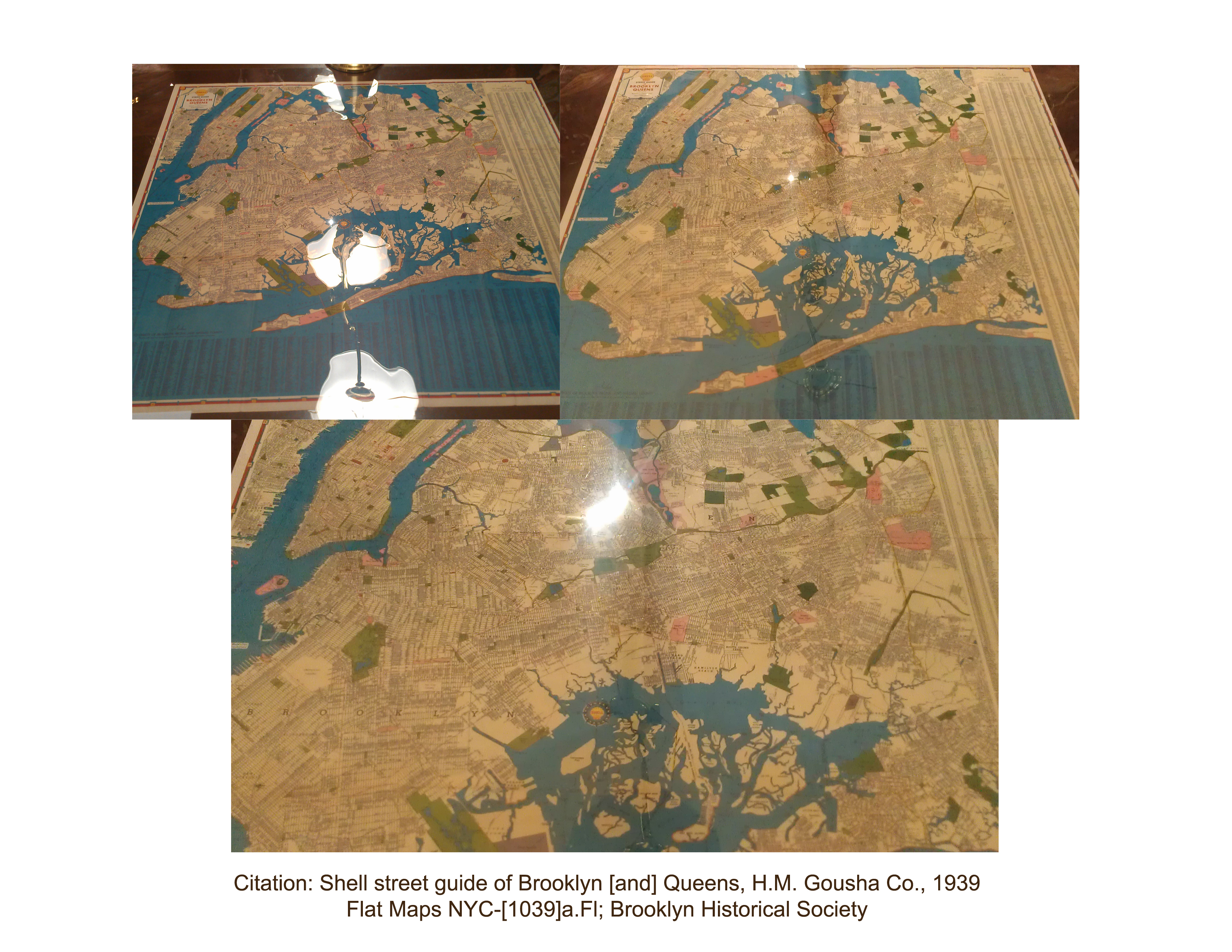
Large Pocket Doors (BHS)
On last class we visited the Brooklyn Historical Society. As far as first impressions go I was floored when we walked up to a gorgeous Red-stone building whose architecture spoke of a rich history that exemplifies what Brooklyn really is. As the enormous pocketed doors opened I got my first glance at a building so full of character that I swore it couldn’t get any better. I have never been so wrong before. We walked into the library archives and my jaw hit the floor. Imagine a library in the house of a lord where rich dark woods and soft lighting play of the binding of the thousands of books sitting nestled on the dark wooden shelves. As we got to work my definition of what Brooklyn is changed. For me Brooklyn today is just another place with buildings and homes just a regular part of New York.
I looked at a few different documents about Brooklyn’s history and I was floored. It’s been like this for so many years. I saw a picture of the BMT Train line looking onto the train line to the west from 16th avenue. Today this isthe line that the N Train runs on and has remained relatively unchanged. I can say that I went down this line several times and didn’t realize that it has been the same for so long. I also looked at a map of the train lines that were present in 1939 and there were a few lines that are still around and in use today. On this map I saw a picture of the Metropolitan Tower from 1939 and that has also remained relatively unchanged.
In thinking about the big guy from “Only the Dead Know Brooklyn” he tried to know Brooklyn by visiting as much of it as he could and experiencing it firsthand. He had a map which showed basic directions and transportation routes similar to the ones we had. He chose to visit Bensonhurst which was easy enough to find on the map. I agree with the protagonist that Brooklyn is a place so enormous and vast in its diversity that it is not possible to know all of it.
I think I know Brooklyn a little bit better than I knew it before our visit to the Brooklyn Historical Society. I have come to appreciate some of the nuances that encompass the borough of Brooklyn.
The BHS Experience.
Our recent visit to the Brooklyn Historical society was very beneficial to my understanding of my hometown and also of our reading of “Only The Dead Know Brooklyn.” I had no knowledge of the Brooklyn Historical society prior to this class and once I heard about this trip I was looking forward to it. I can now say that I enjoyed the trip, not just because we got to leave the classroom but I found everything about the BHS so interesting and inspiring. I loved the architecture, and the mood of the building. It isn’t like a mundane public library. The resources are rare and precious and the BHS is very cautious about how their resources are shared with the public.
Being there was also constructive because we were able to have a hands-on experience with the materials. The group I worked with had a display of two maps of Brooklyn. One map was a railroad map and the other was a transit map. We also had folders that contained photographs of scenes in Brooklyn in much earlier times. I particularly studied a photo that showed the beach at Coney Island from the summer of 1958. I, along with one of the BHS hosts had noticed that many of these beach-goers were fully dressed in the summer time. I thought that this could be attributed to the different culture at the time and maybe people were more reserved in the way they dressed, even at the sunny beach.
Our study of the maps went along very well with our reading of “Only The Dead Know Brooklyn.” In the story “the big guy” claimed to use a map to find his way around Brooklyn. He found he’s way to Bensonhurst, Flatbush, and Red Hook. I found this interesting because these neighborhoods are not exactly very close to each other, and I mentally made a comparison to the time this story took place (it was published in 1935) and today and how maps are hardly used. Every now and then I’ll see a subway passenger squinting at a map, but technology has advanced and nowadays many people use GPS or search for directions online. One can make the argument that technology has made us lazy in this regard because reading a map successfully requires extra effort.
One thing I must point out, however, is that I could not locate Red Hook on the transit map I studied. I just could not find it, but I was indeed able to find “Bensenhoist.” Brooklyn is a very big and deep borough, and I agree that one may never able to to know Brooklyn through and through.
BHS + “Only The Dead Know Brooklyn”
Our visit to the Brooklyn Historical Society was very interesting and taught me things about Brooklyn that i never knew, including what the BHS was, even though I’ve been in Brooklyn most of my life. We got to look at many things such as the map of the borough of Brooklyn from January 1st, 1925. The map was somewhat the same as it is today, except in some places where they used to run railroads or trains but it is a normal street that we walk on. Also, as a classmate mentioned, a place that was considered to be Brooklyn back then in 1925 is no longer a part of Brooklyn, but now is a part of the borough of Queens, which i never knew was possible and i found that interesting.
In “Only The Dead Know Brooklyn” the “big guy” was asking for directions to get to Bensonhurst, even when he had a map. Looking at the map “Brooklyn and How to get to the Worlds Fair” which was around the same time, it shows all the routes, and was pretty easy to follow, and which are similar to our maps now. He tries to get to know Brooklyn by visiting random places and not even knowing what to expect. The main guy says to him that he will never get to know all of Brooklyn because he lived there his whole life and still hasn’t got to know it through and through.


